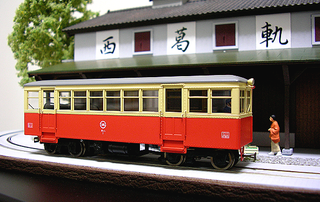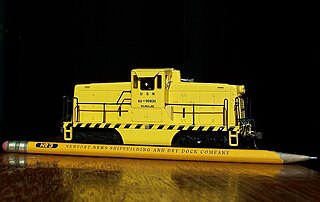
Railway modelling or model railroading is a hobby in which rail transport systems are modelled at a reduced scale.

G scale or G gauge, also called large scale, is a track gauge for model railways which is often used for outdoor garden railways because of its size and durability. G scale trains use a fixed track gauge of 45 millimetres (1.75 in) to accommodate a range of rail transport modelling scales between narrow gauge (~1:13‒1:19‒1:20), metre gauge (1:22.5), Playmobil trains (~1:24), and standard gauge (~1:29–1:32).

LGB stands for Lehmann Gross Bahn - the "Lehmann Big Train" in German. Made by Ernst Paul Lehmann Patentwerk in Nuremberg, Germany, since 1968 and by Märklin since 2007, it is the most popular garden railway model in Europe, although there are also many models of U.S. and Canadian prototypes. LGB caused a revival of garden model railroading in the United States when it was introduced. LGB is sold in North America through Wm. K. Walthers, who took over from Ernst Paul Lehmann's subsidiary, LGB of America, when Märklin bought the LGB assets. Most of the European prototypes were manufactured in Germany, while much of the North American rolling stock was made in China. Production was later moved to Hungary.
Digital Command Control (DCC) is a standard for a system for the digital operation of model railways that permits locomotives on the same electrical section of track to be independently controlled.

O scale is a scale commonly used for toy trains and rail transport modelling. Introduced by German toy manufacturer Märklin around 1900, by the 1930s three-rail alternating current O gauge was the most common model railroad scale in the United States and remained so until the early 1960s. In Europe, its popularity declined before World War II due to the introduction of smaller scales.

HO or H0 is a rail transport modelling scale using a 1:87 scale. It is the most popular scale of model railway in the world. The rails are spaced 16.5 millimetres (0.650 in) apart for modelling 1,435 mm standard gauge tracks and trains in HO.

N scale is a popular model railway scale. Depending upon the manufacturer, the scale ranges from 1:148 to 1:160. Effectively the scale is 1:159, 9 mm to 1,435 mm, which is the width of standard gauge railway. However the scale may vary to simulate wide or narrow gauge rail. In all cases, the gauge is 9 mm or 0.354 in. The term N gauge refers to the track dimensions, but in the United Kingdom in particular British N gauge refers to a 1:148 scale with 1:160 track gauge modelling. The terms N scale and N gauge are often inaccurately used interchangeably, as scale is defined as ratio or proportion of the model, and gauge only as a distance between rails. The scale 1:148 defines the rail-to-rail gauge equal to 9 mm exactly, so when calculating the rail or track use 1:160 and for engines and car wheel base use 1:148.

Gebr. Märklin & Cie. GmbH or Märklin is a German toy company. The company was founded in 1859 and is based at Göppingen in Baden-Württemberg. Although it originally specialised in doll house accessories, today it is best known for model railways and technical toys. In some parts of Germany and in Sweden, the company's name is almost synonymous with model railways.

A toy train is a toy that represents a train. It is distinguished from a model train by an emphasis on low cost and durability, rather than scale modeling. A toy train can be as simple as a toy that can run on a track, or it might be operated by electricity, clockwork or live steam. It is typically constructed from wood, plastic or metal. Many of today's steam trains might be considered as real ones as well, providing they are not strictly scale or not enough detailed ones in favor of a robustness appropriate for children or an inexpensive production.
S scale is a model railroad scale modeled at 1:64 scale, S scale track gauge is 22.48 mm (0.885 in). S gauge trains are manufactured in both DC and AC powered varieties. S gauge is not to be confused with toy train standard gauge, a large-scale standard for toy trains in the early part of the 20th century.

TT scale is a model railroading scale at 1:120 scale with a Track gauge of 12 mm between the rails. It is placed between HO scale (1:87) and N scale (1:160). Its original purpose, as the name suggests, was to make a train set small enough to assemble and operate on a tabletop.

1 gauge, gauge 1 or gauge one is a model railway and toy train standard that was popular in the early 20th century, particularly with European manufacturers. Its track measures 1.75 in, making it larger than 0 gauge but slightly smaller than wide gauge, which came to be the dominant U.S. standard during the 1920s.

Bachmann Industries is a Bermuda-registered, Chinese-owned company, globally headquartered in Hong Kong; specialising in model railroading.

A garden railway or garden railroad is a model railway system set up outdoors in a garden. While G is the most popular scale for garden railroads, 16 mm scale has a dedicated and growing following especially in the UK. Model locomotives in this scale are often live steam scale models of British narrow gauge prototypes. 16 mm scale track, the same gauge as O gauge is probably now more popular in the UK than G scale.
HOn30 gauge is the modelling of narrow-gauge railways in HO on N gauge track in 1:87 scale ratio.

On30gauge is the modelling of narrow gauge railways in O scale on HO gauge track in 1:48 scale ratio by American and Australian model railroaders, in 1:43.5 scale ratio by British and French model railroaders and 1:45 by Continental European model railroaders.

Kato Precision Railroad Models is a Japanese manufacturer of model railroad equipment in N and HO scales. Founded in 1957, the Tokyo-based company manufactures models based on Japanese prototypes for the Japanese market, North American prototypes for the North American market and European high-speed trains and Rhaetian Railway trains for the European market. Models for the OO9 market of Ffestiniog Railway engines are also made. The design and distribution of models for the North American market are handled by their U.S. subsidiary, Kato USA, founded in 1986 and located in Schaumburg, Illinois.

On2 gauge is part of the hobby of rail transport modeling. The name is based on the common USA model railroad O scale of 1:48 and refers to the gauge between the rails and the fact that it is narrow gauge, thus 'On2'.
Digital model railway control systems are an alternative to control a layout and simplify the wiring and add more flexibility in operations. A number of control systems are available to operate locomotives on model railways. Analog systems where the speed and the direction of a train is controlled by adjusting the voltage on the track are still popular while they have recently given way to control systems based on computer technology.

















